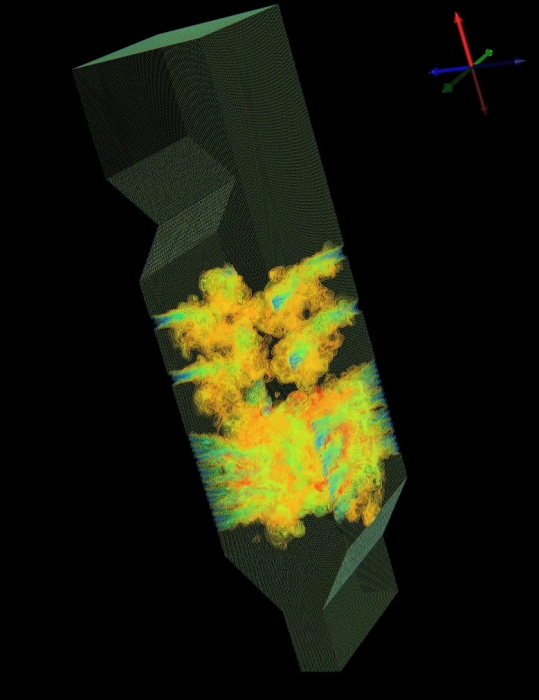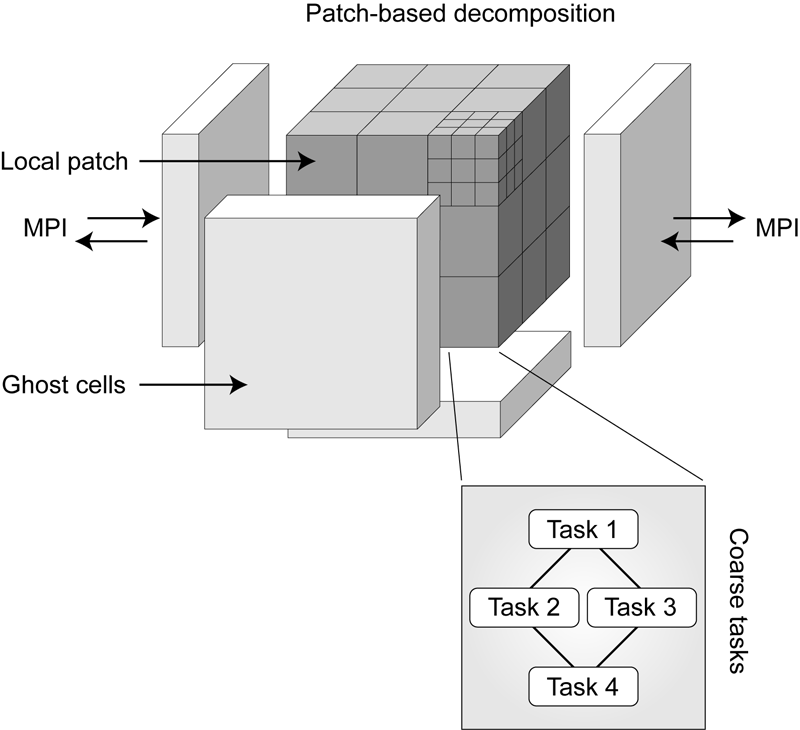SCI Publications
2015
B. Peterson, H. K. Dasari, A. Humphrey, J.C. Sutherland, T. Saad, M. Berzins.
“Reducing overhead in the Uintah framework to support short-lived tasks on GPU-heterogeneous architectures,” In Proceedings of the 5th International Workshop on Domain-Specific Languages and High-Level Frameworks for High Performance Computing (WOLFHPC'15), ACM, pp. 4:1-4:8. 2015.
DOI: 10.1145/2830018.2830023
2014
A. Humphrey, Q. Meng, M. Berzins, D. Caminha B.de Oliveira, Z. Rakamaric, G. Gopalakrishnan.
“Systematic Debugging Methods for Large-Scale HPC Computational Frameworks,” In Computing in Science Engineering, Vol. 16, No. 3, pp. 48--56. May, 2014.
ISSN: 1521-9615
DOI: 10.1109/MCSE.2014.11

Keywords: Computational Modeling and Frameworks, Parallel Programming, Reliability, Debugging Aids
D.C.B. de Oliveira, A. Humphrey, Q. Meng, Z. Rakamaric, M. Berzins, G. Gopalakrishnan.
“Systematic Debugging of Concurrent Systems Using Coalesced Stack Trace Graphs,” In Proceedings of the 27th International Workshop on Languages and Compilers for Parallel Computing (LCPC), September, 2014.
A central need during software development of large-scale parallel systems is tools that help help to identify the root causes of bugs quickly. Given the massive scale of these systems, tools that highlight changes--say introduced across software versions or their operating conditions (e.g., inputs, schedules)--can prove to be highly effective in practice. Conventional debuggers, while good at presenting details at the problem-site (e.g., crash), often omit contextual information to identify the root causes of the bug. We present a new approach to collect and coalesce stack traces, leading to an efficient summary display of salient system control flow differences in a graphical form called Coalesced Stack Trace Graphs (CSTG). CSTGs have helped us understand and debug situations within a computational framework called Uintah that has been deployed at large scale, and undergoes frequent version updates. In this paper, we detail CSTGs through case studies in the context of Uintah where unexpected behaviors caused by different vesions of software or occurring across different time-steps of a system (e.g., due to non-determinism) are debugged. We show that CSTG also gives conventional debuggers a far more productive and guided role to play.
2013
M. Berzins, J. Schmidt, Q. Meng, A. Humphrey.
“Past, Present, and Future Scalability of the Uintah Software,” In Proceedings of the Blue Waters Extreme Scaling Workshop 2012, pp. Article No.: 6. 2013.

Keywords: netl, Uintah, parallelism, scalability, adaptive mesh refinement, linear equations
Q. Meng, A. Humphrey, J. Schmidt, M. Berzins.
“Preliminary Experiences with the Uintah Framework on Intel Xeon Phi and Stampede,” SCI Technical Report, No. UUSCI-2013-002, SCI Institute, University of Utah, 2013.
In this work, we describe our preliminary experiences on the Stampede system in the context of the Uintah Computational Framework. Uintah was developed to provide an environment for solving a broad class of fluid-structure interaction problems on structured adaptive grids. Uintah uses a combination of fluid-flow solvers and particle-based methods, together with a novel asynchronous taskbased approach and fully automated load balancing. While we have designed scalable Uintah runtime systems for large CPU core counts, the emergence of heterogeneous systems presents considerable challenges in terms of effectively utilizing additional on-node accelerators and co-processors, deep memory hierarchies, as well as managing multiple levels of parallelism. Our recent work has addressed the emergence of heterogeneous CPU/GPU systems with the design of a Unified heterogeneous runtime system, enabling Uintah to fully exploit these architectures with support for asynchronous, out-of-order scheduling of both CPU and GPU computational tasks. Using this design, Uintah has run at full scale on the Keeneland System and TitanDev. With the release of the Intel Xeon Phi co-processor and the recent availability of the Stampede system, we show that Uintah may be modified to utilize such a coprocessor based system. We also explore the different usage models provided by the Xeon Phi with the aim of understanding portability of a general purpose framework like Uintah to this architecture. These usage models range from the pragma based offload model to the more complex symmetric model, utilizing all co-processor and host CPU cores simultaneously. We provide preliminary results of the various usage models for a challenging adaptive mesh refinement problem, as well as a detailed account of our experience adapting Uintah to run on the Stampede system. Our conclusion is that while the Stampede system is easy to use, obtaining high performance from the Xeon Phi co-processors requires a substantial but different investment to that needed for GPU-based systems.
Keywords: Uintah, hybrid parallelism, scalability, parallel, adaptive, MIC, Xeon Phi, heterogeneous systems, Stampede, co-processor
Q. Meng, A. Humphrey, J. Schmidt, M. Berzins.
“Investigating Applications Portability with the Uintah DAG-based Runtime System on PetaScale Supercomputers,” SCI Technical Report, No. UUSCI-2013-003, SCI Institute, University of Utah, 2013.
Present trends in high performance computing present formidable challenges for applications code using multicore nodes possibly with accelerators and/or co-processors and reduced memory while still attaining scalability. Software frameworks that execute machineindependent applications code using a runtime system that shields users from architectural complexities offer a possible solution. The Uintah framework for example, solves a broad class of large-scale problems on structured adaptive grids using fluid-flow solvers coupled with particle-based solids methods. Uintah executes directed acyclic graphs of computational tasks with a scalable asynchronous and dynamic runtime system for CPU cores and/or accelerators/coprocessors on a node. Uintah's clear separation between application and runtime code has led to scalability increases of 1000x without significant changes to application code. This methodology is tested on three leading Top500 machines; OLCF Titan, TACC Stampede and ALCF Mira using three diverse and challenging applications problems. This investigation of scalability with regard to the different processors and communications performance leads to the overall conclusion that the adaptive DAG-based approach provides a very powerful abstraction for solving challenging multiscale multi-physics engineering problems on some of the largest and most powerful computers available today.
Keywords: Uintah, hybrid parallelism, scalability, parallel, adaptive, MIC, Xeon Phi, heterogeneous systems, Stampede, co-processor
Q. Meng, A. Humphrey, J. Schmidt, M. Berzins.
“Investigating Applications Portability with the Uintah DAG-based Runtime System on PetaScale Supercomputers,” In Proceedings of SC13: International Conference for High Performance Computing, Networking, Storage and Analysis, pp. 96:1--96:12. 2013.
ISBN: 978-1-4503-2378-9
DOI: 10.1145/2503210.2503250
Present trends in high performance computing present formidable challenges for applications code using multicore nodes possibly with accelerators and/or co-processors and reduced memory while still attaining scalability. Software frameworks that execute machine-independent applications code using a runtime system that shields users from architectural complexities offer a possible solution. The Uintah framework for example, solves a broad class of large-scale problems on structured adaptive grids using fluid-flow solvers coupled with particle-based solids methods. Uintah executes directed acyclic graphs of computational tasks with a scalable asynchronous and dynamic runtime system for CPU cores and/or accelerators/co-processors on a node. Uintah's clear separation between application and runtime code has led to scalability increases of 1000x without significant changes to application code. This methodology is tested on three leading Top500 machines; OLCF Titan, TACC Stampede and ALCF Mira using three diverse and challenging applications problems. This investigation of scalability with regard to the different processors and communications performance leads to the overall conclusion that the adaptive DAG-based approach provides a very powerful abstraction for solving challenging multi-scale multi-physics engineering problems on some of the largest and most powerful computers available today.
Keywords: Blue Gene/Q, GPU, Xeon Phi, adaptive, application, co-processor, heterogeneous systems, hybrid parallelism, parallel, scalability, software, uintah, NETL
Q. Meng, A. Humphrey, J. Schmidt, M. Berzins.
“Preliminary Experiences with the Uintah Framework on Intel Xeon Phi and Stampede,” In Proceedings of the Conference on Extreme Science and Engineering Discovery Environment: Gateway to Discovery (XSEDE 2013), San Diego, California, pp. 48:1--48:8. 2013.
DOI: 10.1145/2484762.2484779
In this work, we describe our preliminary experiences on the Stampede system in the context of the Uintah Computational Framework. Uintah was developed to provide an environment for solving a broad class of fluid-structure interaction problems on structured adaptive grids. Uintah uses a combination of fluid-flow solvers and particle-based methods, together with a novel asynchronous task-based approach and fully automated load balancing. While we have designed scalable Uintah runtime systems for large CPU core counts, the emergence of heterogeneous systems presents considerable challenges in terms of effectively utilizing additional on-node accelerators and co-processors, deep memory hierarchies, as well as managing multiple levels of parallelism. Our recent work has addressed the emergence of heterogeneous CPU/GPU systems with the design of a Unified heterogeneous runtime system, enabling Uintah to fully exploit these architectures with support for asynchronous, out-of-order scheduling of both CPU and GPU computational tasks. Using this design, Uintah has run at full scale on the Keeneland System and TitanDev. With the release of the Intel Xeon Phi co-processor and the recent availability of the Stampede system, we show that Uintah may be modified to utilize such a co-processor based system. We also explore the different usage models provided by the Xeon Phi with the aim of understanding portability of a general purpose framework like Uintah to this architecture. These usage models range from the pragma based offload model to the more complex symmetric model, utilizing all co-processor and host CPU cores simultaneously. We provide preliminary results of the various usage models for a challenging adaptive mesh refinement problem, as well as a detailed account of our experience adapting Uintah to run on the Stampede system. Our conclusion is that while the Stampede system is easy to use, obtaining high performance from the Xeon Phi co-processors requires a substantial but different investment to that needed for GPU-based systems.
Keywords: MIC, Xeon Phi, adaptive, co-processor, heterogeneous systems, hybrid parallelism, parallel, scalability, stampede, uintah, c-safe
D.C.B. de Oliveira, Z. Rakamaric, G. Gopalakrishnan, A. Humphrey, Q. Meng, M. Berzins.
“Crash Early, Crash Often, Explain Well: Practical Formal Correctness Checking of Million-core Problem Solving Environments for HPC,” In Proceedings of the 35th International Conference on Software Engineering (ICSE 2013), pp. (accepted). 2013.
While formal correctness checking methods have been deployed at scale in a number of important practical domains, we believe that such an experiment has yet to occur in the domain of high performance computing at the scale of a million CPU cores. This paper presents preliminary results from the Uintah Runtime Verification (URV) project that has been launched with this objective. Uintah is an asynchronous task-graph based problem-solving environment that has shown promising results on problems as diverse as fluid-structure interaction and turbulent combustion at well over 200K cores to date. Uintah has been tested on leading platforms such as Kraken, Keenland, and Titan consisting of multicore CPUs and GPUs, incorporates several innovative design features, and is following a roadmap for development well into the million core regime. The main results from the URV project to date are crystallized in two observations: (1) A diverse array of well-known ideas from lightweight formal methods and testing/observing HPC systems at scale have an excellent chance of succeeding. The real challenges are in finding out exactly which combinations of ideas to deploy, and where. (2) Large-scale problem solving environments for HPC must be designed such that they can be \"crashed early\" (at smaller scales of deployment) and \"crashed often\" (have effective ways of input generation and schedule perturbation that cause vulnerabilities to be attacked with higher probability). Furthermore, following each crash, one must \"explain well\" (given the extremely obscure ways in which an error finally manifests itself, we must develop ways to record information leading up to the crash in informative ways, to minimize offsite debugging burden). Our plans to achieve these goals and to measure our success are described. We also highlight some of the broadly applicable concepts and approaches.
Keywords: Uintah
2012
A. Humphrey, Q. Meng, M. Berzins, T. Harman.
“Radiation Modeling Using the Uintah Heterogeneous CPU/GPU Runtime System,” SCI Technical Report, No. UUSCI-2012-003, SCI Institute, University of Utah, 2012.
The Uintah Computational Framework was developed to provide an environment for solving fluid-structure interaction problems on structured adaptive grids on large-scale, long-running, data-intensive problems. Uintah uses a combination of fluid-flow solvers and particle-based methods for solids, together with a novel asynchronous task-based approach with fully automated load balancing. Uintah demonstrates excellent weak and strong scalability at full machine capacity on XSEDE resources such as Ranger and Kraken, and through the use of a hybrid memory approach based on a combination of MPI and Pthreads, Uintah now runs on up to 262k cores on the DOE Jaguar system. In order to extend Uintah to heterogeneous systems, with ever-increasing CPU core counts and additional onnode GPUs, a new dynamic CPU-GPU task scheduler is designed and evaluated in this study. This new scheduler enables Uintah to fully exploit these architectures with support for asynchronous, outof- order scheduling of both CPU and GPU computational tasks. A new runtime system has also been implemented with an added multi-stage queuing architecture for efficient scheduling of CPU and GPU tasks. This new runtime system automatically handles the details of asynchronous memory copies to and from the GPU and introduces a novel method of pre-fetching and preparing GPU memory prior to GPU task execution. In this study this new design is examined in the context of a developing, hierarchical GPUbased ray tracing radiation transport model that provides Uintah with additional capabilities for heat transfer and electromagnetic wave propagation. The capabilities of this new scheduler design are tested by running at large scale on the modern heterogeneous systems, Keeneland and TitanDev, with up to 360 and 960 GPUs respectively. On these systems, we demonstrate significant speedups per GPU against a standard CPU core for our radiation problem.
Keywords: csafe, uintah
A. Humphrey, Q. Meng, M. Berzins, T. Harman.
“Radiation Modeling Using the Uintah Heterogeneous CPU/GPU Runtime System,” In Proceedings of the first conference of the Extreme Science and Engineering Discovery Environment (XSEDE'12), Association for Computing Machinery, 2012.
DOI: 10.1145/2335755.2335791
The Uintah Computational Framework was developed to provide an environment for solving fluid-structure interaction problems on structured adaptive grids on large-scale, long-running, data-intensive problems. Uintah uses a combination of fluid-flow solvers and particle-based methods for solids, together with a novel asynchronous task-based approach with fully automated load balancing. Uintah demonstrates excellent weak and strong scalability at full machine capacity on XSEDE resources such as Ranger and Kraken, and through the use of a hybrid memory approach based on a combination of MPI and Pthreads, Uintah now runs on up to 262k cores on the DOE Jaguar system. In order to extend Uintah to heterogeneous systems, with ever-increasing CPU core counts and additional onnode GPUs, a new dynamic CPU-GPU task scheduler is designed and evaluated in this study. This new scheduler enables Uintah to fully exploit these architectures with support for asynchronous, outof- order scheduling of both CPU and GPU computational tasks. A new runtime system has also been implemented with an added multi-stage queuing architecture for efficient scheduling of CPU and GPU tasks. This new runtime system automatically handles the details of asynchronous memory copies to and from the GPU and introduces a novel method of pre-fetching and preparing GPU memory prior to GPU task execution. In this study this new design is examined in the context of a developing, hierarchical GPUbased ray tracing radiation transport model that provides Uintah with additional capabilities for heat transfer and electromagnetic wave propagation. The capabilities of this new scheduler design are tested by running at large scale on the modern heterogeneous systems, Keeneland and TitanDev, with up to 360 and 960 GPUs respectively. On these systems, we demonstrate significant speedups per GPU against a standard CPU core for our radiation problem.
Keywords: Uintah, hybrid parallelism, scalability, parallel, adaptive, GPU, heterogeneous systems, Keeneland, TitanDev
Q. Meng, A. Humphrey, M. Berzins.
“The Uintah Framework: A Unified Heterogeneous Task Scheduling and Runtime System,” In Digital Proceedings of The International Conference for High Performance Computing, Networking, Storage and Analysis, Note: SC’12 –2nd International Workshop on Domain-Specific Languages and High-Level Frameworks for High Performance Computing, WOLFHPC 2012, pp. 2441--2448. 2012.
DOI: 10.1109/SCC.2012.6674233
The development of a new unified, multi-threaded runtime system for the execution of asynchronous tasks on heterogeneous systems is described in this work. These asynchronous tasks arise from the Uintah framework, which was developed to provide an environment for solving a broad class of fluid-structure interaction problems on structured adaptive grids. Uintah has a clear separation between its MPI-free user-coded tasks and its runtime system that ensures these tasks execute efficiently. This separation also allows for complete isolation of the application developer from the complexities involved with the parallelism Uintah provides. While we have designed scalable runtime systems for large CPU core counts, the emergence of heterogeneous systems, with additional on-node accelerators and co-processors presents additional design challenges in terms of effectively utilizing all computational resources on-node and managing multiple levels of parallelism. Our work addresses these challenges for Uintah by the development of new hybrid runtime system and Unified multi-threaded MPI task scheduler, enabling Uintah to fully exploit current and emerging architectures with support for asynchronous, out-of-order scheduling of both CPU and GPU computational tasks. This design coupled with an approach that uses MPI to communicate between nodes, a shared memory model on-node and the use of novel lock-free data structures, has made it possible for Uintah to achieve excellent scalability for challenging fluid-structure problems using adaptive mesh refinement on as many as 256K cores on the DoE Jaguar XK6 system. This design has also demonstrated an ability to run capability jobs on the heterogeneous systems, Keeneland and TitanDev. In this work, the evolution of Uintah and its runtime system is examined in the context of our new Unified multi-threaded scheduler design. The performance of the Unified scheduler is also tested against previous Uintah scheduler and runtime designs over a range of processor core and GPU counts.
Page 2 of 2
